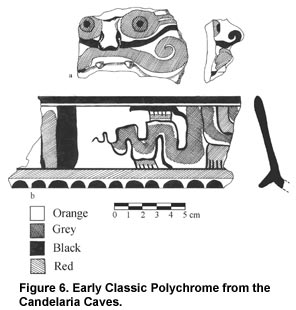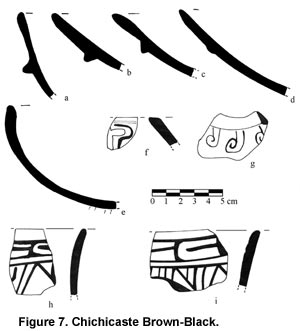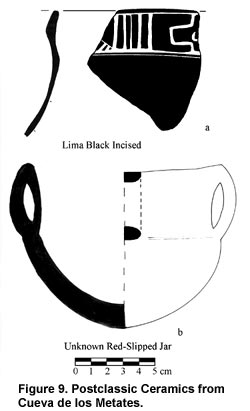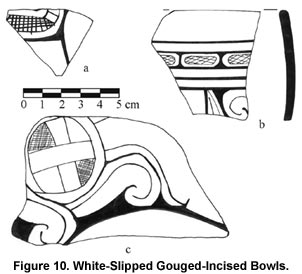
| FAMSI © 2005: Brent Woodfill |
||
Archaeological Investigations in the Candelaria Caves and La Lima, Alta Verapaz, Guatemala Ceramics from the Caves Unlike other caves in the area (Bill et al. 2003, Woodfill et al. 2005), use of the Candelaria system begins relatively late, with a miniscule amount of material recovered from the Terminal Preclassic. Use peaks in the latter part of the Early Classic (Tzakol 2 and 3), at which point it greatly overshadows other ceremonial centers in the rest of the region (Woodfill and Monterroso 2005). A smaller, more restricted period of use is found at the eastern, downriver part of the system in the Late Classic, surrounding the site of La Lima. While use before the Late Classic is almost exclusively lowland-oriented with locally-produced wares directly imitating modes from the Central Petén (Woodfill et al. 2005), ceramics from this time period are mostly local, Alta Verapaz in style (cf. R. Smith 1952, Arnauld 1987, Arnauld 1986) with a small amount of lowland material presumably imported or brought by ritual practitioners from further north found within the cave system but not in the site itself. Interestingly, in spite of the sheer quantity of ceramics from the caves (with an average of over 10 kg. in each 5 cm. level excavated in the 2004 field season), there is very little variation in form, type, and decoration in the Early Classic, and the clay used to make the vast majority of vessels seems to have been from the same source (INAA samples have been taken by Bishop and are awaiting analysis), even though the Early Classic and Late Classic ceramics are from different spheres (Petén and Alta Verapaz) and use different technologies (quartz and calcite in the Early Classic and ash, sand, and vegetal matter in the Late Classic). All of this strongly suggests that the ceramics were locally-made. Early Classic Ceramics from the Candelaria Caves There is very little variation in forms and types in the caves (Woodfill and Monterroso 2005). The largest represented type is Quintal Unslipped (mostly jars with a few spiked incensarios), followed by Águila Orange (mostly jars with a few curved Z-angle bowls). There is a wide range of color for Águila slips, from dull orange (2.5YR5/8) to bright orange (2.5YR6/8) to reddish-orange (10R5/8), although there is minimal variation in paste with this and all other Early Classic types. The Dos Arroyos collection (Figure 6b, shown below), which is slightly smaller than Águila, is almost exclusively composed of basal-flanged bowls, with a few interior-slipped open bowls and a small amount of jars identical to those in the Águila group with the addition of red and black slip in simple geometrical patterns. There is very little variation in the iconography represented here–with few exceptions, all of the Dos Arroyos-group ceramics contain the "Serpent Head X" complex identified by Robert Smith (1955). Balanza-group ceramics are the most variable, with a few basal-flanged bowls, cylindrical slab-footed tripod vessels, open bowls, and jars. There is a small amount of outlying ceramics – Fama Buff and Pucte Brown jars, a Dos Arroyos hemispherical bowl with an appliquéd "Curl Mouth" face (Figure 6a, shown above, Taube, pers. comm. 2005), and thin cylindrical vases with a cream and specular red slip, but the majority of vessels are much more standardized in form, decoration, and paste than one would expect for a pilgrimage site with no large nearby settlement. In addition, the ceramics are much more closely related to the Central Petén than to sites in the southwestern Petén, which are larger, thicker, and, in the case of Dos Arroyos Orange Polychrome, with much larger basal flanges and higher sides. There is, however, a minority variation of Dos Arroyos with a bright orangish paste, a large quantity of mica, and a cruder, more-easily-eroded slip which appears in small quantities in sites around Aguateca (Woodfill personal observation 2005). Late Classic Ceramics from La Lima and Associated Caves In the Late Classic, there is little doubt as to the local origin of the cave ceramics, as they are identical to those in La Lima. Vessels in this time frame have an interesting mix of northern highland and southern lowland characteristics – the technology is identical to that found by Arnauld (1986) and Smith (1952) in southern and central Alta Verapaz and Ichon (1992) in Quiché, with ash, sand, or organic temper and easily-eroded slips, but the forms are significantly different than those previously reported, with several new types and almost exclusively local varieties of pre-existing types having been identified (Monterroso 2005, Woodfill and Monterroso 2005). Service wares in La Lima are exclusively sand- or ash-tempered and, while in many cases the slip is too poorly preserved to be certain, the majority of vessels seem to have been slipped brown (Chichicaste Brown-Black [Figure 7, shown above], identified by Arnauld [1986]), with a lesser quantity of red, cream, orange, and black surfaces. In spite of the similarity in paste and many of the modes to examples from further south, however, it is difficult to assign a specific type to the majority of vessels, and, at least in some cases no pre-existing type could be used. An example of this is "Sechochoc Black" (Woodfill and Monterroso 2005, Figure 8, shown below) a northern highland version of Infierno Black – delicate plates with a small, sometimes-modified basal flange. While the sherds are ash-tempered (typical of highland pieces), black slip has not been identified in previous studies in the Northern Highlands, nor does the particular form appear.
There are also several plates associated with the last construction episode that are identical in form and decoration to Altar Orange and Trapiche Incised except for the presence of ash and ground pumice mixed into the paste (Ibid.). Two examples of Early Postclassic Alta Verapaz vessels (Figure 9, shown below) were uncovered from one of the associated caves – a black Z-angled bowl with incised pseudoglyphs (Lima Black Incised [Arnauld 1986]), and a small red-slipped jar with thick walls and four handles. Although lowland ceramics are completely absent from La Lima (several examples are found in associated caves, however), some of the sample is identical to vessels from around Carcha, although in limited quantities. So-called Monkey pots (Smith 1952) were found scattered throughout the site, and in the caves were found several examples of a cream gouged-incised bowl with a band of pseudoglyphs below the rim and an orange lip (Figure 10, shown below, cf. Arnauld 1986: 424, fig. 182). Many of the decorative modes used at La Lima are shared with other sites in the Northern Lowlands, including cross-hatched deep incisions, bands of single or clustered reed-stampings, basal or medial ridges, alternating bands of different colors near the interior rim of bowls, and interior smudging. Although there are a few Cambio pots and sherds in the caves, all of the utilitarian ware in La Lima is either Cebada Porous (Arnauld 1986) or related types (Woodfill and Monterroso 2005). The Cebada from the site (Figure 11, shown below), however, shares characteristics of both neighboring regions – the vessels are extremely light-weight, due to organic temper (which burned away in the firing process, leaving large pores throughout the paste), and the surfaces, while pockmarked, have been well-smoothed. However, the ubiquitous loop-handles found in specimens further to the south are completely lacking, and the form much more closely resembles Cambio with its wide-flaring mouth and continuous curve between the body and the neck. In contrast, Cebada from further south often has a break between the body and the neck (at the point of articulation with the handles) and only a slightly out-curved rim (Arnauld 1986).
The Impact of Excavations in La Lima It is the definition of a local variety of Cebada Porous that may prove to be the most important contribution of La Lima. Since its identification by Marion Hatch (pers. comm. 2005), it has also been found to have composed a large quantity of the utilitarian wares at Cancuén (Monterroso, personal observation 2005) and makes an occasional appearance in Late Classic samples as far north as the Petexbatún (Castellanos and Woodfill, personal observations 2005). The La Caoba area, under investigation by VUPACS in 2001 and 2002 (Woodfill et al. 2003), also has evidence of this type both in caves and on the surface, mixed in with other general Cancuén-sphere types. Some studies have successfully used utilitarian ceramics, which are often used as a marker for determining ethnicity (Berlin and Slane 1999, Sanders 1977, Spence 1996), as the technology used to make them as well as the jobs for which they were made tend to change very little over time within the same group. The lack of any highland utilitarian ceramics in the Candelaria Caves or other parts of the region in Early Classic contexts seems to indicate that in the Late Classic there was an influx of population into the region from the south. The identification of this type, which has been grouped into Cambio in previous investigations in the Upper Pasión, will allow present and future scholars to better understand the relationship between highland and lowland groups here and potentially further north. |
||
|
Text links to all pages at this site are available at the FAMSI INDEX |
||





